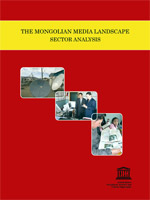Publications
The Mongolian Media Landscape: Sector Analysis

This media sector analysis identifies a set of critical problems for the development of free and independent media in Mongolia. As an overall assessment the media sector still faces challenges in fulfilling its pivotal role in the democratization process as a watchdog and as the provider of relevant and independent information for the public.
On its path towards media freedom, Mongolia has seen some inspiring developments but has also faced major setbacks. Following the political transition in 1990 print media sprang up extensively, and since the late 1990’s a host of electronic media has been launched. The actual media output in the capital as well as the countryside is impressive both in numbers and variety. There were 340 media outlets in 2005 serving a population of 2.5 million people. However, the sector faces many challenges.
Despite the many media and communication initiatives that exist in the country and are supported by various donor organisations, the Mongolian government does not have a comprehensive media and communication policy that deals in a systematic way with the huge challenges facing the industry, including the lack of infrastructure and the creation of a viable market for media and communication products in rural areas.
For these reasons it is extremely important to increase support for free and independent media and progressive civil society groups in a sustainable fashion; but within the specific context in which Mongolian media professionals operate. The issues faced by media on a national level (Ulaanbaatar) and in the countryside are diverse but equally problematic, and a different approach is necessary to support their development.
Despite the many media and communication initiatives that exist in the country and are supported by various donor organisations, the Mongolian government does not have a comprehensive media and communication policy that deals in a systematic way with the huge challenges facing the industry, including the lack of infrastructure and the creation of a viable market for media and communication products in rural areas.
For these reasons it is extremely important to increase support for free and independent media and progressive civil society groups in a sustainable fashion; but within the specific context in which Mongolian media professionals operate. The issues faced by media on a national level (Ulaanbaatar) and in the countryside are diverse but equally problematic, and a different approach is necessary to support their development.
 Download Download |
|---|
 Details Details |
|---|




